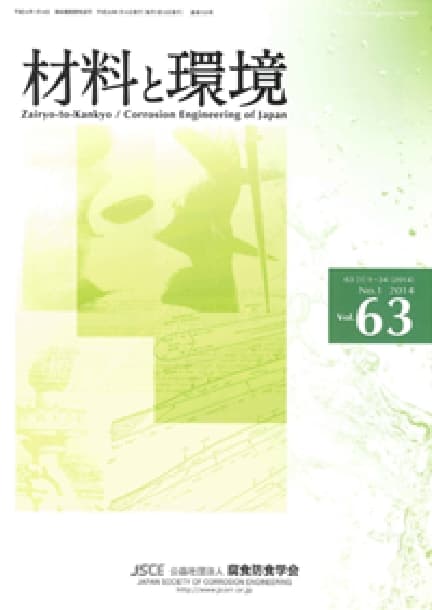- TOP
- Zairyo-to-Kankyo
- Vol. 63 (2014), No. 7
Zairyo-to-Kankyo Vol. 63 (2014), No. 7
Backnumber
-
Vol. 74 (2025)
-
Vol. 73 (2024)
-
Vol. 72 (2023)
-
Vol. 71 (2022)
-
Vol. 70 (2021)
-
Vol. 69 (2020)
-
Vol. 68 (2019)
-
Vol. 67 (2018)
-
Vol. 66 (2017)
-
Vol. 65 (2016)
-
Vol. 64 (2015)
-
Vol. 63 (2014)
-
Vol. 62 (2013)
-
Vol. 61 (2012)
-
Vol. 60 (2011)
-
Vol. 59 (2010)
-
Vol. 58 (2009)
-
Vol. 57 (2008)
-
Vol. 56 (2007)
-
Vol. 55 (2006)
-
Vol. 54 (2005)
-
Vol. 53 (2004)
-
Vol. 52 (2003)
-
Vol. 51 (2002)
-
Vol. 50 (2001)
-
Vol. 49 (2000)
-
Vol. 48 (1999)
-
Vol. 47 (1998)
-
Vol. 46 (1997)
-
Vol. 45 (1996)
-
Vol. 44 (1995)
-
Vol. 43 (1994)
-
Vol. 42 (1993)
-
Vol. 41 (1992)
-
Vol. 40 (1991)
Keyword Ranking
08 Jan. (Last 30 Days)
Zairyo-to-Kankyo Vol. 63 (2014), No. 7
Futher Considerations on Corrosion and Inhibition Phenomena of Anions Based on the Hard and Soft Acids and Bases Principle
Kunitsugu Aramaki
pp. 417-426
DOI:
10.3323/jcorr.63.417Abstract
A comprehensible explanation of the hard and soft acids and bases principle (HSAB principle) is described in this review first. Inhibition and stimulation of the anodic process for iron corrosion in an acid solution containing various anions are interpreted on the basis of the HSAB principle. Further, effects of anions on passive film breakdown of iron in solutions of various anions are discussed using the principle.
Simulations of Intergranular Corrosion Feature for Stainless Steel using Cellular Automata Method
Takahiro Igarashi, Atsushi Komatsu, Takafumi Motooka, Fumiyoshi Ueno, Yoshiyuki Kaji, Masahiro Yamamoto
pp. 431-437
DOI:
10.3323/jcorr.63.431Abstract
In order to obtain the relation between an intergranular corrosion behavior and an impurities for stainless steel, cellular automata modeling and simulation of intergranular corrosion was carried out. From intergranular corrosion simulation considering non-uniform phosphorus component distribution on grain boundary, it suggested that complicated intergranular corrosion shape as in experimental data was caused by the large precipitation of phosphorus compounds in part of grain boundary.
Prediction of Alternating Current Density and Cathodic Current Density Flowing into Holiday of Buried Coated Steel Pipe
Takao Kitagawa, Kenichi Haraga
pp. 438-442
DOI:
10.3323/jcorr.63.438Abstract
Cathodic protection is applied to prevent AC corrosion and soil corrosion, which are generated in holiday of buried coated steel pipe. However, there is no way to measure the current density flowing into holiday, cathodic protection is managed as an index to earth surface potential or the current density of a probe buried near the steel pipe. We developed new method for estimating the alternating current density by non-digging. Also we showed the effectiveness of the method through the verification experiment. The proposed method is expected to be applied for cathodic protection management of buried steel pipe.
Article Access Ranking
08 Jan. (Last 30 Days)
-
Delayed Fracture Mechanism of 1700 MPa-Class Quenched and Tempered Bolt under Atmospheric Corrosion Environment
Tetsu-to-Hagané Advance Publication
-
Perspectives on the Promising Pathways to Zero Carbon Emissions in the Steel Industry toward 2050
ISIJ International Vol.65(2025), No.2
-
Effect of B on Surface Oxidation Behavior and Phosphatability of Si-Mn-added Cold-Rolled Steel Sheets
ISIJ International Advance Publication
-
Processability and Microstructural Morphology of γ-Fe/Fe2Nb Two-Phase Eutectic Alloy Manufactured by Laser Powder Bed Fusion
Tetsu-to-Hagané Vol.112(2026), No.1
-
Growth, Removal, and Agglomeration of Various Type of Oxide Inclusions in Molten Steel
ISIJ International Advance Publication
-
Thermodynamic Reassessment and Phase Diagram Calculations of the Fe–P and Fe–C–P Systems
Tetsu-to-Hagané Advance Publication
-
Metallurgical Aspects on Interstitial Free Sheet Steel From Industrial Viewpoints
ISIJ International Vol.34(1994), No.1
-
Influence of Ni Impurity in Steel on the Removability of Primary Scale in Hydraulic Descaling
ISIJ International Vol.37(1997), No.3
-
Hydrogen Embrittlement in Titanium and Its Alloys
Zairyo-to-Kankyo Vol.60(2011), No.5
-
Elasto-plastic Behavior and Yield Bending Strength of Column Splice Consisting Square Hollow Sections with Different Outer Diameters Filling Their Gaps with Mortar
Kou kouzou rombunshuu Vol.32(2025), No.126
You can use this feature after you logged into the site.
Please click the button below.










